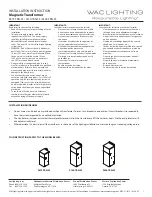
18
Section 3
Model 752 and 752A Differential Pressure Transmitters
monitored). Follow the guidelines in Appendix A that are specific to your
piping configuration.
3.
Open the block valves if applicable (recommended for liquid service, but
not for gas).
NOTE:
For gas service, it is recommended that a zero check be performed with
both block valves closed. If the gas flow is pulsating, there may be a
standing wave effect in the process line which can displace the indicator
and appear as a zero error.
4. Apply electrical power to the transmitter loop.
5. Check the transmitter calibration across all checkpoints, using the
instructions provided in
. If re-adjustment of the zero
and/or span is necessary, perform all 12 steps described in the
6. Check the manifold and piping for leaks as follows:
a.
Open the bypass valve(s), then open one shutoff valve to pressurize
the instrument.
b. Close the shutoff valve and the bypass valve.
c. Any leakage will be indicated by a change (increase or decrease) in
the transmitter output.
NOTE:
Be careful not to subject the DPU to unnecessary shock or overrange
pressure during operations.
Shutdown Procedure
To shut down operations, perform the following steps. See the installation
, for typical valve locations.
1. Remove electrical power from the transmitter loop.
2. Close the transmitter shut-off valves.
3. Close the main block valves at the process connections.
4.
Open the transmitter drain valves and remove all pressure from the unit.
















































